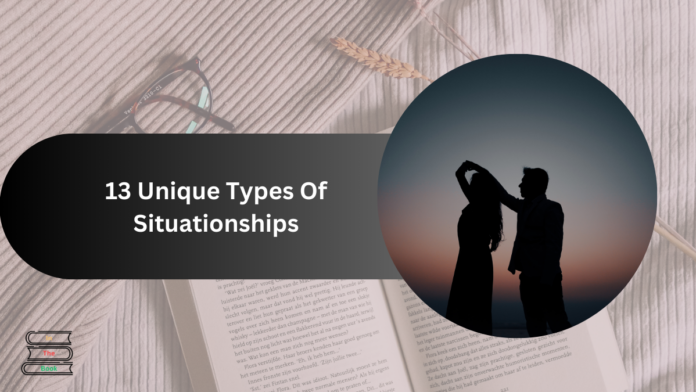In the modern dating world, situationships have become common. They exist somewhere between friendship and a committed relationship. Understanding the different types can help you navigate these complex relationships better. Each types of situationships has its own unique dynamics and characteristics.
Contents
- The friends with benefits
- The almost relationship
- The placeholder
- The secret relationship
- The long-distance fling
- The on-and-off relationship
- The no-strings-attached
- The emotional fling
- The transition relationship
- The convenience relationship
- The mentor/mentee relationship
- The experimental relationship
- The toxic relationship
- Understanding situationships
- The role of communication
- Self-awareness and boundaries
- Potential for growth or transition
- Conclusion
- Some Questions
- What is a situationship?
- How can I tell if I’m in a situationship?
- Can a situationship turn into a serious relationship?
- How do I navigate a situationship?
- What are the benefits of a situationship?
- Read More:
The friends with benefits
You might know this type well. Two people maintain a friendship while also having a physical relationship. Both of you typically understand there are no romantic commitments involved.
You enjoy each other’s company and the added benefit of intimacy without the pressure of a traditional relationship.
The almost relationship
You might find yourself in an almost relationship. You and the other person act like a couple in many ways but never officially label your relationship.
You might go on dates, spend a lot of time together, and even meet each other’s friends and family. However, you avoid the “boyfriend” or “girlfriend” titles, keeping things ambiguous.
The placeholder
In a placeholder situationship, you or the other person are involved as a temporary solution. This usually happens when someone is waiting for the right person to come along but doesn’t want to be alone in the meantime.
You might enjoy each other’s company but know that the relationship isn’t likely to become serious.
The secret relationship
You might be in a secret relationship if you keep it hidden from others. This could be due to various reasons, such as wanting to avoid gossip, not being ready to go public, or having other complicated personal situations.
The secrecy can add excitement but also complicates things when it comes to building a deeper connection.
The long-distance fling
A long-distance fling happens when two people live far apart but maintain a relationship that involves seeing each other sporadically.
You depend heavily on digital communication and can have intense moments when you meet. However, the distance usually keeps things from becoming too serious.
The on-and-off relationship
You might experience an on-and-off situationship, where the couple goes through cycles of being together and breaking up.
You have strong feelings for each other but struggle to maintain a stable relationship. This types of situationships can be emotionally draining due to its unpredictability.
The no-strings-attached
In a no-strings-attached situationship, you focus solely on the physical connection without emotional ties. Both of you agree to keep things casual and avoid any romantic expectations. It’s about enjoying each other’s company physically without any commitment.
The emotional fling
An emotional fling is when you share deep emotional connections without a physical relationship. You confide in each other, share secrets, and offer support, but there’s no romantic or physical involvement.
This types of situationships can be fulfilling yet confusing, as it blurs the lines of friendship and romance.
The transition relationship
You might find yourself in a transition relationship when you are moving on from a serious relationship and aren’t ready for another one yet. You seek comfort and companionship from another person but aren’t looking for anything serious.
The situationship serves as a bridge during a time of emotional healing.
The convenience relationship
In a convenience situationship, you stay together mainly due to convenience. This could be due to living arrangements, mutual friends, or other practical reasons.
The relationship may not have a strong emotional or romantic foundation, but it works for both parties due to their current circumstances.
The mentor/mentee relationship
This unique type involves one person taking on a mentor role while the other is the mentee. It’s common in professional settings but can also occur in personal development contexts.
The relationship is built on mutual respect and admiration, though it may also include romantic or physical elements.
The experimental relationship
In an experimental situationship, individuals explore different aspects of their identity or preferences.
This might involve trying out new relationship dynamics, exploring sexuality, or simply understanding what they want in a partner. The focus is on learning and growth rather than commitment.
The toxic relationship
A toxic situationship is characterized by unhealthy behaviors such as manipulation, control, or emotional abuse.
One or both parties might be aware of the toxicity but find it hard to leave due to emotional dependency or other factors. This types of situationships can be harmful and draining.
Understanding situationships
Recognizing the types of situationships you are in can help you manage expectations and navigate the relationship better. Situationships can offer flexibility and freedom but also come with their own set of challenges.
Communication and self-awareness are key to ensuring that your needs and boundaries are respected.
The role of communication
Open communication is crucial in any situationship. It’s important to discuss what you both want from the relationship and set clear boundaries.
Misunderstandings can lead to hurt feelings and complications, so being upfront can help maintain harmony.
Self-awareness and boundaries
Knowing yourself and what you want is essential. Be honest about your intentions and ensure that you are not compromising your own needs for the sake of convenience or temporary comfort. Setting boundaries can help protect your emotional well-being.
Potential for growth or transition
While some situationships remain casual, others can evolve into more serious relationships. It’s possible to grow closer over time and develop a deeper connection. Conversely, some may transition out of the situationship as personal circumstances change.
Conclusion
Situationships come in many forms, each with its own dynamics and challenges. Understanding these unique types can help you navigate your own relationships with more clarity and confidence.
Whether you are in a friends-with-benefits scenario, an almost relationship, or any other type, the key is to communicate openly and know your own boundaries. Situationships can be complex, but they also offer opportunities for learning and growth.
Some Questions
What is a situationship?
A situationship is a romantic or sexual relationship that lacks clear commitment or labels.
How can I tell if I’m in a situationship?
If your relationship lacks clear boundaries, labels, or commitments, it might be a situationship.
Can a situationship turn into a serious relationship?
Yes, some situationships can evolve into more serious relationships with time and communication.
Open communication and self-awareness are key to navigating a situationship successfully.
What are the benefits of a situationship?
Situationships offer flexibility and freedom without the pressures of a traditional relationship.
Read More:
- The Real Reason Invoices Go Unpaid — And How Collection Automation Can Fix It
- Best Places to Buy Diamonds and Engagement Rings Online
- Building Focus and Strategy Through Interactive Digital Experiences
- How Students’ Reading Interests Influence Their Motivation and Performance in Writing Assignments
- The Damages Resulting from the Use of Suboxone

Chandler is an avid automobile enthusiast who is passionate about all things on wheels. From the latest car models to classic vintage rides, I love exploring the automotive world’s intricate details and engineering marvels. With years of experience in test-driving, reviewing, and analyzing cars, I provide readers with comprehensive insights and honest opinions.


























